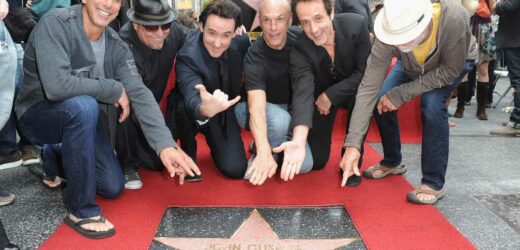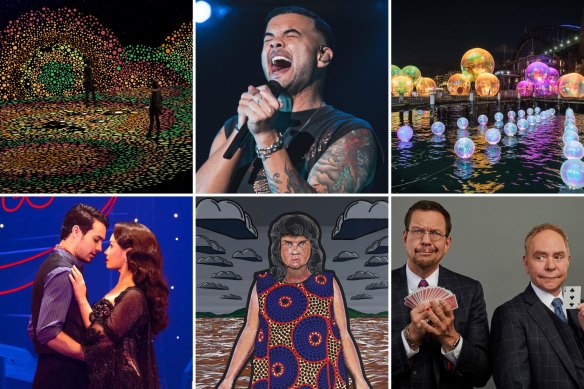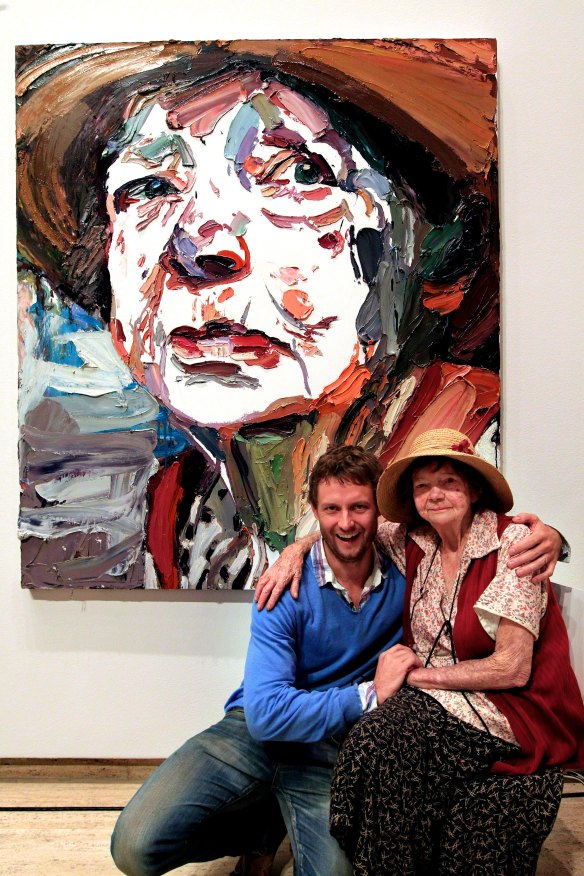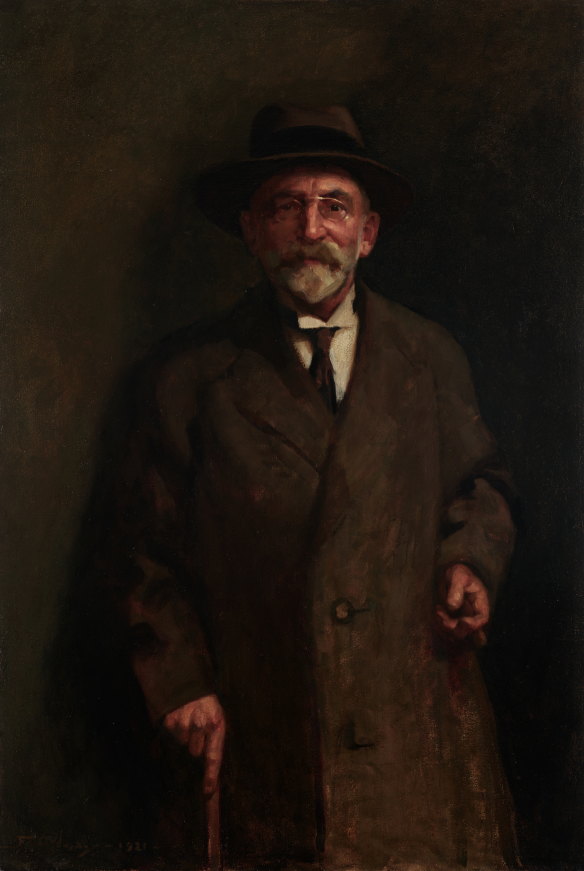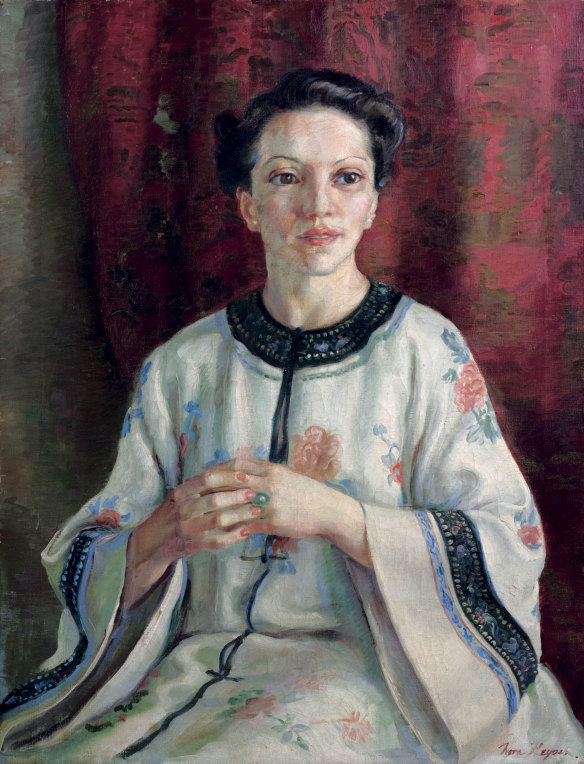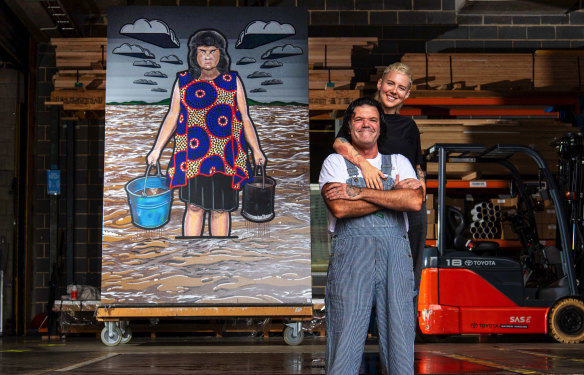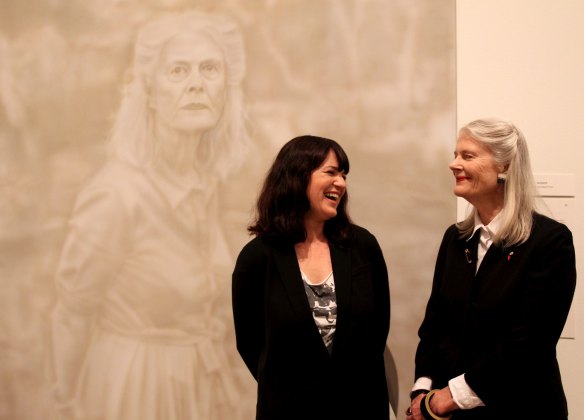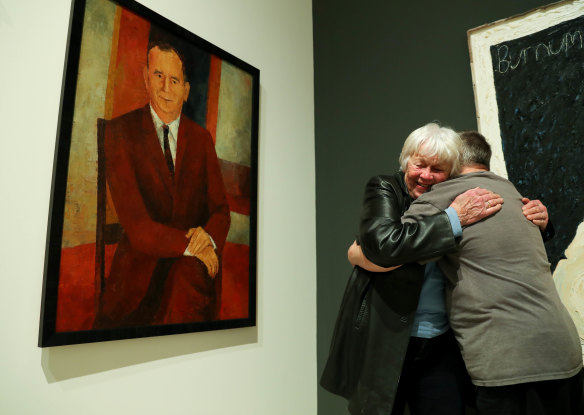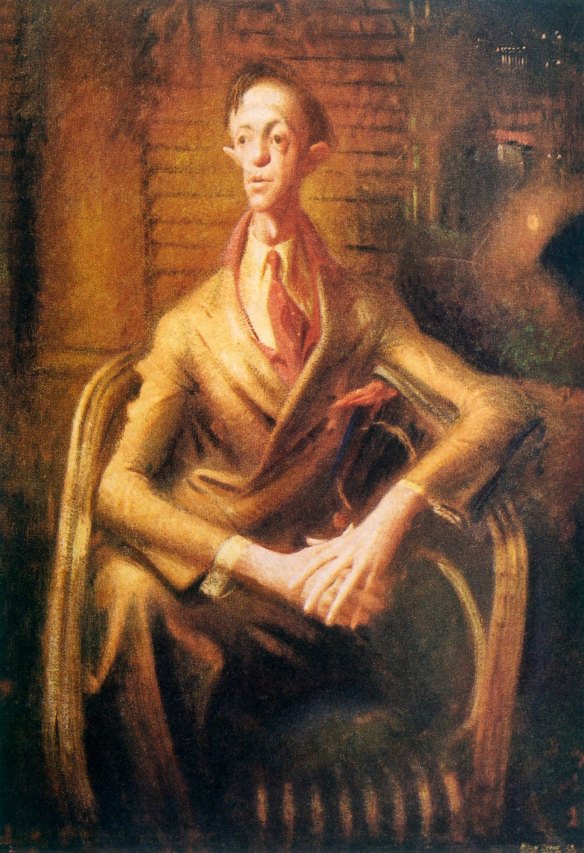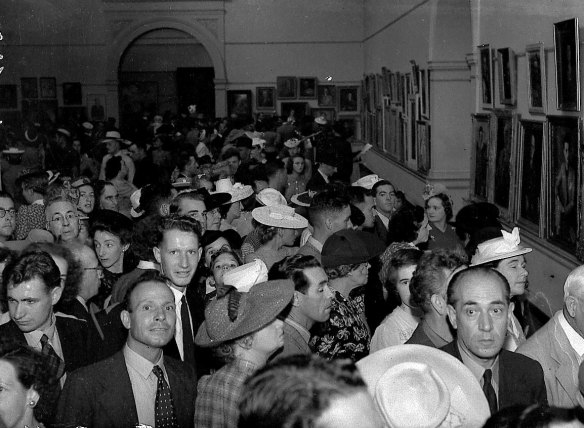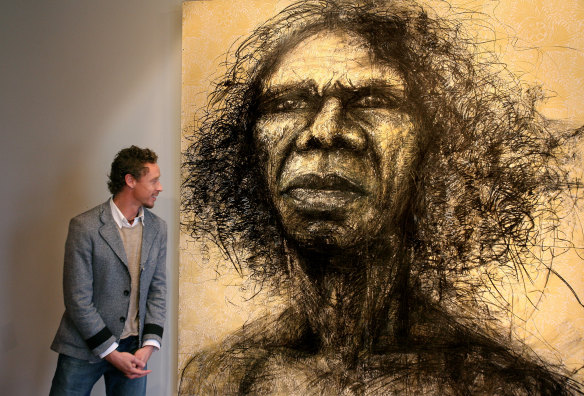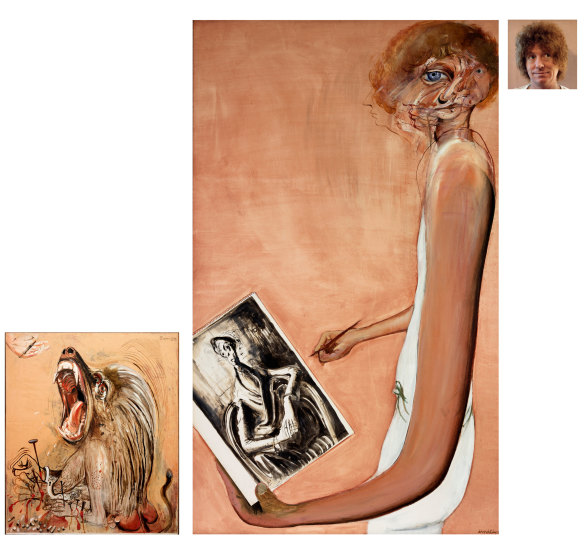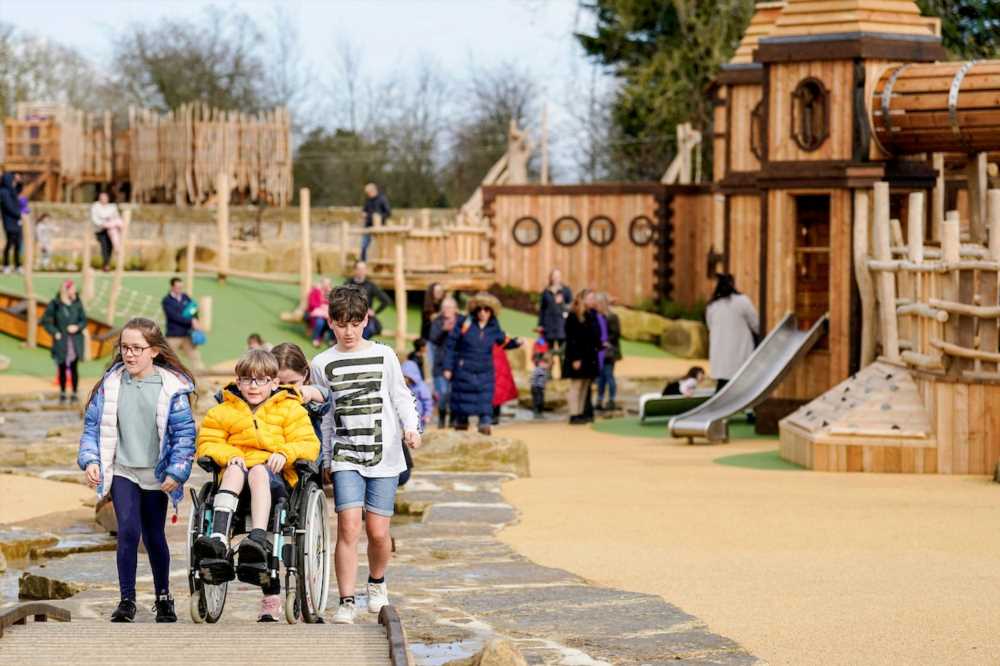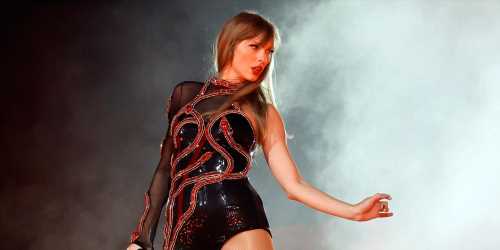By Helen Pitt
The best things to do and shows to see in Sydney in June 2022, including: taking in the Walking Through a Songline exhibition; seeing Guy Sebastian in concert; walking Walsh Bay to see Ephemeral Oceanic; marvelling at Penn & Teller; checking out the Archibald entries and watching Moulin Rouge the Musical.Credit:Mosster; Rick Clifford; Blak Douglas, Daniel Boud
The Archibald Prize is the oldest and most prestigious portrait competition in Australia, but not the richest. That accolade goes to the $150,000 Doug Moran National Portrait Prize. But the $100,000, 102-year-old Archibald is our most famous and best-loved. It has also launched or solidified careers of some of the country’s leading artists including William Dobell, Judy Cassab, Clifton Pugh, Del Kathryn Barton, John Olsen, Ben Quilty, Wendy Sharpe and Nicholas Harding.
Archibald prize winner Ben Quilty with Margaret Olly the subject of his 2010 Archibald Prize winning portrait.Credit:Edwina Pickles
What’s the big deal?
Love it or hate it, the Archibald is the Art Gallery of NSW’s most popular exhibition. Art critic Robert Hughes in 1962 declared it “not so much a competition as a myth”. Former Art Gallery of NSW director Ed Capon used to call it “a discreet form of perving”, but the key to its success, he said, was that “the general public feels a strange sense of ownership of the Archibald” because it is “of the people, by the people for the people”.
The Sydney Morning Herald art critic John McDonald says: “The Archibald ‘stops the nation’ in the same way and has a similar inflated status and recognition value as the Melbourne Cup. One could say its main appeal is as folklore, not as a great art exhibition. Treat it as high entertainment … For better or worse, it’s still the greatest publicity bonanza in Australian art.” The Archibald, like the Melbourne Cup, is popular with the punters; you can even bet on the winner.
Who is the Archibald who gives his name to the prize?
JF Archibald, the namesake of Australia’s best-known prize for portraiture, was the founding editor of The Bulletin magazine. Born John Feltham Archibald in 1856 just outside of Geelong in Victoria, the Francophile changed his name to Jules François Archibald and had great visions for elevating Australia’s colonial culture to something more European.
The weekly magazine he edited, first published in 1880 focused on Australian politics, business and literature and was known for its cartoons and black and white illustrations. In 1900, Archibald commissioned Melbourne artist John Longstaff to paint a colour portrait of poet Henry Lawson, one of the regular contributors at The Bulletin.
Ironically, Archibald hated having his picture painted. But when he became a trustee of the Art Gallery of NSW in 1915, the Gallery commissioned Florence Rodway to paint a portrait in oil of the ailing man in 1919, the year he died. He left money in his will for an annual portrait prize to document the Australians “distinguished in art, letters, science or politics”.
The Florence Rodway portrait of JF Archibald, for whom the portrait prize is named.Credit:Art Gallery of NSW
The £90,000 he left was split between the portrait prize bearing his name (one-tenth), the commissioning of the Archibald Fountain in Hyde Park and a benevolent fund for journalists (which still operates today). The compound interest on that initial £9000 set aside for the competition, has seen the winner’s prize money grow from £400 in 1921, about double the average annual male wage at the time, to $100,000 in 2023.
How many portraits have been painted for the competition since it began in 1921?
More than 32,000 entries (not including 2023 entries) have been received since the prize began; by far the bulk are self-portraits or artists painting other artists. But because the prize is not acquisitive, only about 100 remain in the Art Gallery of NSW collection. Sometimes sitters buy or are given the works. Some have been known to destroy their painting if they don’t like it. Lewis Miller, a 1998 winner, famously destroyed an early 1990s portrait of then merchant banker Malcolm Turnbull, when the future PM said it made him look like a “big, fat greedy c–t”. Before 1946, everything that was entered was hung, but after that only finalists have made the art gallery walls.
How many women have won the Archibald?
The 1938 Archibald Prize winner,Nora Heysen’s <i>Mme Elink Schuurman</i>.Credit:Art Gallery of NSW
Only 10 women have won the Archibald Prize in its 102-year history. Nora Heysen, daughter of landscape artist Hans Heysen was the first in 1938 with a portrait of Madame Elink Schuurman. Judy Cassab was next in 1960 and 1967 with portraits of her artist friends Stanislaus Rapotec and Margot Lewers. Janet Dawson (1973) Davida Allen (1986) Wendy Sharpe (1996) Cherry Hood (2002) Del Kathryn Barton (2008 and 2013) Fiona Lowry (2014) Louise Hearman (2016) and Yvette Coppersmith (2018) have all taken the honours. In 2021, the year the prize celebrated a century, an equal number of female artists to males were hung as finalists for the first time – 26 each.
How many Indigenous Artists have won the Archibald?
Two. Last year’s winner Blak Douglas with his portrait of friend and fellow Indigenous painter Karla Dickens, and Vincent Namatjira in 2020, who was the first First Nations artist to win.
His great-grandfather, Hermannsburg painter Albert Namatjira was painted by eight-time Archibald winner William Dargie, and it won the 1956 competition.
Blak Douglas and fellow artist Kim Leutwyler with his 2022 winning portrait of Karla Dickens in March.Credit:Nick Moir
Archibald Prize portraits from 2022: James Powditch’s Laura Tingle – the fourth estate, Kathrin Longhurst’s Irrational, Hong Fu’s Portrait of Peter Wegner, Jude Rae’s The big switch – portrait of Dr. Saul Griffith, Catherine McGuiness’ Rosary with the seagull and Mathew Lynn’s Yaka moto, Magic Pierre.Credit:Art Gallery of NSW
Who are the judges?
The 11 trustees of the Art Gallery of NSW. In 2023 they include Art Gallery president, David Gonski who is also chancellor of the University of NSW, Art Gallery director Michael Brand, philanthropist Andrew Cameron, paediatrician and Macquarie University vice-chancellor S. Bruce Dowton, arts advocate Anita Belgiorno-Nettis, businessman Lachlan Edwards, former investment banker Kiera Grant, former financial services director Sally Herman, businesswoman and arts philanthropist Liz Lewin, arts administrator and advocate Paris Neilson, artist Caroline Rothwell and Indigenous artist Tony Albert.
Winner of the 2014 Archibald Prize, Fiona Lowry with her subject, Penelope Seidler, at the NSW Art Gallery in Sydney.Credit:Janie Barrett
Have they ever not awarded a winner?
Yes. Twice. For the first time in 1964, when the judges declared there was no worthy winner. Their decision was questioned on the centenary of the prize in 2021, after Natalie Wilson, curator of the Archie 100 exhibition unearthed a 1964 entry of Methodist minister Ted Noffs by Estonian-born artist Tiiu Reissar.
After 53 years gathering dust and mould in the artist’s Blue Mountains home, the painting was rehung and Wilson and the court of public opinion declared the judges were wrong at the Archie 100 exhibition (which was interrupted due to COVID-19). Again in 1980, the newly elected trustees awarded no prize because they thought the entries were “below standard”. As one art dealer summed it up back then: “had the Melbourne Cup winner been below standard, the horse would not have lost the prize.”
Artist Tiiu Reissar meets Wesley Noffs again, 50 years since she was his art teacher, and 57 years since she painted this portrait of his father Ted Noffs for the 1964 Archibald Prize. Credit:Janie Barrett
What are the prize’s great controversies?
The first scandal occurred in 1934, with commercial artist Henry Hanke’s self-portrait in the tattered clothes he wore as a relief worker in the Great Depression. As a cost-cutting measure, Hanke used the earthworks he laboured with on the roads as the source of his pigments on the painting. It was the first self-portrait to be declared a winner. But controversy ensued because he was not considered by some to be “distinguished” enough in arts, per the rules.
But the real drama began in 1943 when William Dobell won for his painting of his friend Joshua Smith.
William Dobell’s controversial <i>Portrait of an Artist (Joshua Smith)</i>, 1943.Credit:Art Gallery of NSW
When Dobell’s win was announced, two other entrants – Mary Edwards and Joseph Wolinski – took legal action against Dobell and the Trustees on the grounds that the painting was not a portrait as defined by the Archibald Bequest, but a caricature.
The case was heard in the Supreme Court in October 1944 and was seen by many as putting modern art on trial. The court eventually found in favour of Dobell’s work and ordered the claimants pay costs for Dobell and the Trustees. This was followed by an appeal and an unsuccessful demand to the Equity Court to restrain the Trustees from handing over the prize money.
Sunday crowds at the 1945 Archibald exhibition.Credit:Fairfax Archive
Visitors flocked to view Dobell’s “outrageously modern” work. They stood 10 people deep before it, and at one point a gallery attendant had to take the painting off the wall to persuade the crowd to go home.
A record 7800 people jammed into the gallery one afternoon and the exhibition had to be extended a month to cope with demand. When the Archibald show closed that year, 140,000 people had viewed the painting; 10 per cent of Sydney’s population.
Artist Craig Ruddy with his 2004 Archibald Prize winning portrait of David Gulpilil.Credit:Robert Pearce
In 2004, Craig Ruddy’s Gulpilil portrait, won both the then $35,000 first prize and the people’s choice award. Rival artist Tony Johansen took unsuccessful legal action against the Art Gallery of NSW Trust, claiming it was a charcoal drawing, not a painting. Ruddy painted the Aboriginal actor two other times as Archibald entries, and tragically died at 53 of COVID-19 in 2022.
Has anyone ever won the Archibald, Wynne and Sulman prizes all at once?
Brett Whiteley remains the only artist to have won the Archibald, Wynne and Sulman prizes in the same year, 1978. It was his second Archibald Prize, with a self-portrait of him holding the 1943 Joshua Smith painting in his hand. His Wynne prize was Summer at Carcoar and his Sulman was the Yellow nude.
Archibald Prize 1978 winner Brett Whiteley’s ‘Art, life and the other thing’.Credit:Art Gallery of NSW
When is it on display?
It is shown annually, in conjunction with The Wynne Prize, awarded to the best landscape painting of Australian scenery, or figure sculpture, and the Sulman Prize, given to the best subject painting, genre painting or mural. The three exhibitions open at the Art Gallery of NSW from May 6 until September 3, and the Archibald will open at the Mornington Peninsula Regional Gallery from September 15 until November 5, before touring regional NSW. The deadline for entries this year is March 31. Finalists are announced on April 27 along with the packing room prize and the winner is announced on May 5.
A cultural guide to going out and loving your city. Sign up to our Culture Fix newsletter here.
Most Viewed in Culture
Source: Read Full Article
